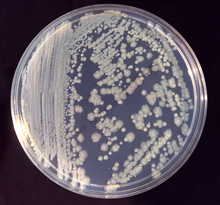- Enterobacter
-
Enterobacter 
Enterobacter cloacae on Tryptic Soy Broth agar. Scientific classification Kingdom: Bacteria Phylum: Proteobacteria Class: Gammaproteobacteria Order: Enterobacteriales Family: Enterobacteriaceae Genus: Enterobacter
Hormaeche & Edwards 1960Species E. aerogenes
E. amnigenus
E. agglomerans
E. asburiae
E. cancerogenous
E. cloacae
E. cowanii
E. dissolvens
E. gergoviae
E. hormaechei
E. intermedius
E. kobei
E. ludwigii
E. nimipressuralis
E. pyrinus
E. sakazakiiSynonyms Cloaca Castellani & Chalmers, 1919
Aerobacter Hormaeche & Edwards, 1958Enterobacter is a genus of common Gram-negative, facultatively-anaerobic, rod-shaped bacteria of the family Enterobacteriaceae. Several strains of the these bacteria are pathogenic and cause opportunistic infections in immunocompromised (usually hospitalized) hosts and in those who are on mechanical ventilation. The urinary and respiratory tract are the most common sites of infection. It is also a fecal coliform, along with Escherichia.
Two clinically-important species from this genus are E. aerogenes and E. cloacae.
Contents
Diagnosis
Its laboratory characteristics are lactose positive, and indole negative.[1]
Treatment
1. Fourth generation of cephalosporin,a β-lactam antibiotic Cefepime 2. Imipenem (carbapenems) is of choice in enterobacter treatment. 3. Aminoglycosides such as amikacin have been found very effective as well.[1] 4. Quinolones are an effective alternative.[1]
References
- ^ a b c Russo Thomas A, Johnson James R, "Chapter 143. Diseases Caused by Gram-Negative Enteric Bacilli" (Chapter). Fauci AS, Braunwald E, Kasper DL, Hauser SL, Longo DL, Jameson JL, Loscalzo J: Harrison's Principles of Internal Medicine, 17e: http://www.accessmedicine.com/content.aspx?aID=2894446.
External links

This Proteobacteria-related article is a stub. You can help Wikipedia by expanding it.
